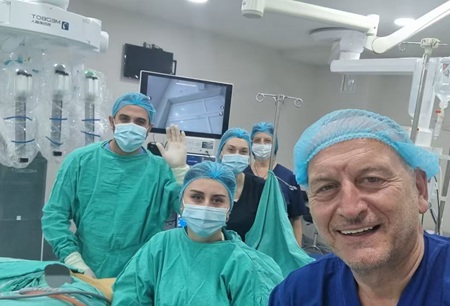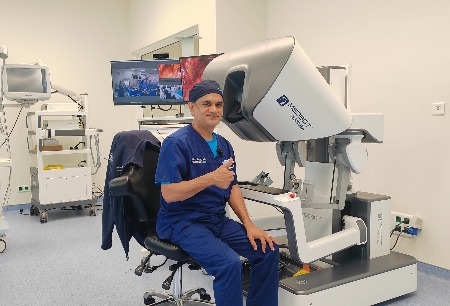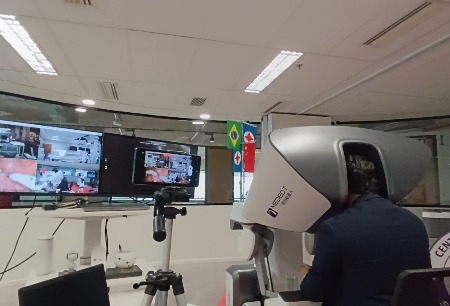Xinjiang, China - On April 13, 2023, at the Urological Surgery Center of the People's Hospital of Xinjiang Uygur Autonomous Region (hereinafter referred to as "The People's Hospital of Xinjiang Autonomous Region"), the chief surgeon, Prof. Jiuzhi Li, and his assistant, Dr. Xun Li, successfully completed a difficult ureteral bladder replantation with the assistance of the Toumai® Laparoscopic Surgical Robot (hereinafter referred to as "Toumai®"). With its 3D vision, flexible and precise instrument performance, Toumai® helps the demanding surgical suturing process. Like a tailor-made tool, it helps surgeons provide more accurate, safe treatment solutions for patients, improving treatment effect and efficiency for the benefit of more patients.
The left kidney was 103×48 mm in size, with abnormal shape, unsmooth envelope, thinning cortex, unclear demarcation of renal cortex and medulla, and 38 mm separation of renal pelvis and calyces. The left ureter was fully dilated with a width of 10-17mm. The prostate was enlarged. No occupying lesions were seen in the right kidney and bladder. The right ureter was not dilated.
To alleviate the patient's left hydronephrosis and preserve the function of the left kidney as much as possible, Director Jiuzhi Li considered using surgical robotic assistance for left ureteral bladder replantation. First of all, ureteral bladder replantation is the main surgical method for the treatment of lower ureteral stenosis, which has narrow operating space and is difficult to expose the operating area. Secondly, ureteral bladder replantation is a common ureteral functional reconstruction surgery, which requires a large number of complex suture reconstruction operations after the resection of the ureteral stenosis. With the help of Toumai®, various problems can be solved, and the use of robotic surgery can not only make up for the shortcomings of narrow operating space and difficult exposure, but also give full play to the advantages of convenient suture than traditional laparoscopic and open surgery.
With the continuous improvement and optimization of Toumai®, its application in urologic surgery, especially complex reconstruction surgery, is expanding. Compared to open surgery, Toumai® has a naked-eye 3D magnification of more than 10 times, providing surgeons with clear, complete, and layered high-definition images of the patient's body cavity. Compared with ordinary laparoscopic surgery, this is more convenient for the surgeon to control the operating distance, identify the anatomical structure, thus improving the surgical accuracy. Additionally, the toolarm of Toumai® has seven degrees of freedom, which breaks the limits of human hands and allows the surgeon to operate the instrument more flexibly. It can also automatically filter out the shaking caused by manual operation, showing unparalleled stability and accuracy. For procedures such as ureteral bladder replantation, which requires delicate operation in a small space, it is ideal for use with the Toumai® Laparoscopic Surgical Robot.
After anesthesia, the patient was placed in a dorsal elevated position, and after routine disinfection and draping, a 1cm longitudinal incision was made on the patient's umbilical cord to insert the lens trocar. After the pneumoperitoneum was established, the remaining operation ports and helper ports were drilled on both sides of the lens port under the direct view of the endoscope, and the ports were fan-like distributed. After opening the peritoneal reflexion, the ureter and its lesions were exposed and separated. The upper end of the ureteral stenosis was found, the lateral wall of the bladder was cut open, and the inner section of the ureteral wall was cut open and separated to resect the ureteral lesion. Due to the stenosis of the lower part of the left ureter, a "giant ureter" of about 1cm had formed, which can not be directly replanted. Therefore, considering the ureteral tension during replantation, Director Jiuzhi Li decided to split the bulging ureter and use ureteral anastomosis to perform coiled tube anastomosis first, and then reconstruction anastomosis. Although, this was a big challenge for the main surgeon's anastomosis technique. After two hours of operation with the assistance of Toumai®, Director Jiuzhi Li completed the surgery efficiently and smoothly.
Toumai® has impressive performance in suturing, which is capable of carrying out precise resection, suture reconstruction and other operations in the narrow space. In addition, the master-slave teleoperation structure of Toumai® frees the main surgeon and assistant to a certain extent, which makes it easier for us to concentrate for longer periods of time and perform finer operations.
-
 2024-11-18Karazanashvili Robotic Center Completed 100 Toumai® Robot-Assisted Surgeries, becoming the Only Robotic Surgery Center in the Caucasus Region
2024-11-18Karazanashvili Robotic Center Completed 100 Toumai® Robot-Assisted Surgeries, becoming the Only Robotic Surgery Center in the Caucasus Region -
 2024-10-26TOUMAI® SURGICAL ROBOT SYSTEM COMPLETES MULTIPLE LANDMARK ROBOTIC TELESURGERY CASES IN SUB-SAHARA AFRICA IN THE REPUBLIC OF ANGOLA
2024-10-26TOUMAI® SURGICAL ROBOT SYSTEM COMPLETES MULTIPLE LANDMARK ROBOTIC TELESURGERY CASES IN SUB-SAHARA AFRICA IN THE REPUBLIC OF ANGOLA -
 2024-10-26Toumai® Achieves South America's First Tele-Surgery Demonstration
2024-10-26Toumai® Achieves South America's First Tele-Surgery Demonstration






 Hu ICP Bei No. 20013662 HGWA Bei No. 31011502015178
Hu ICP Bei No. 20013662 HGWA Bei No. 31011502015178 " are registered trademarks of Shanghai MicroPort Medical (Group) Co., Ltd.” . They have been authorized to be used by Shanghai Microport Medbot (Group) Co., Ltd., and no other party shall use such trademarks without prior written permission thereof.
" are registered trademarks of Shanghai MicroPort Medical (Group) Co., Ltd.” . They have been authorized to be used by Shanghai Microport Medbot (Group) Co., Ltd., and no other party shall use such trademarks without prior written permission thereof.
